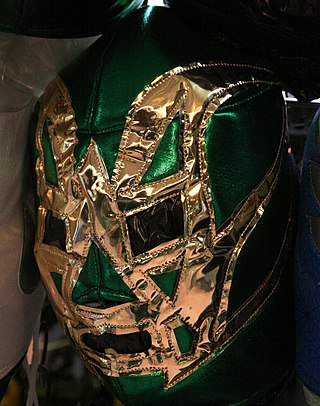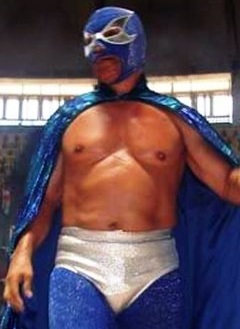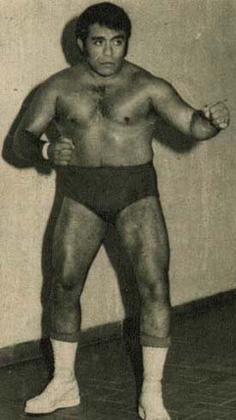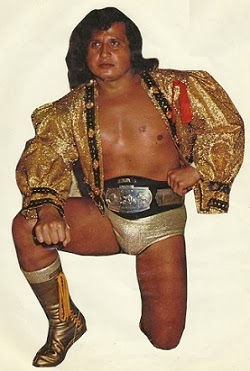Related Research Articles

Salvador Guerrero Quesada, better known as Gory Guerrero, was one of the premier Mexican-American professional wrestlers in the early days of Lucha Libre when most wrestlers were imported from outside Mexico. He wrestled primarily in Empresa Mexicana de la Lucha Libre (EMLL) between the 1940s and 1960s. He was also the patriarch of the Guerrero wrestling family.
Pedro Aguayo Damián better known as "(El) Perro Aguayo" and El Can de Nochistlan was a Mexican wrestler through the 1970s to the 1990s.
Roberto Gutiérrez Frías is a Mexican retired professional wrestler and wrestling trainer, best known under the ring name El Dandy. He is the cousin of professional wrestler Juan Conrado Aguilar, known as El Texano, and the uncle of Aguilar's sons, who wrestle as El Texano Jr. and Súper Nova. While he had a retirement tour in 2014, Gutiérrez has wrestled most recently in March 2019. Gutiérrez has wrestled for most major Mexican promotions, including Consejo Mundial de Lucha Libre, Lucha Libre AAA Worldwide, Universal Wrestling Association, World Wrestling Association, and International Wrestling Revolution Group. In addition, he has worked for the US-based World Championship Wrestling as well as the Japanese Super World Sports and the International Wrestling Association of Japan.

José Ángel Nájera Sánchez was a Mexican luchador or professional wrestler best known under the ring name Fishman. Fishman was one of the top wrestlers in the mid-1970s and 1980s and worked for Empresa Mexicana de Lucha Libre, the Universal Wrestling Association, the World Wrestling Association and AAA in Mexico as well as frequent trips to Japan and the United States. Nájera was unmasked after losing a match in 2000 and retired shortly afterwards. Three of his sons are all luchadores enmascarados known by their ring names Black Fish, El Hijo del Fishman and El Único de Ciudad Juárez.
Sangre Chicana is the ring name of retired Mexican professional wrestler Andrés Durán Reyes. Reyes made his professional wrestling debut in 1973, wearing a red mask with a gold stripe, under the name Lemus. A year later he changed his name to Sangre Chicana but kept the mask with the golden stripe. He rose to prominence in a feud with El Cobarde and Fishman that led to a Lucha de Apuesta, mask vs. mask match where Reyes lost his mask.
Carmelo Reyes González is a Mexican retired professional wrestler, better known by his ring name, Cien Caras. He is best known for his appearances with the Consejo Mundial de Lucha Libre.

Juan Baños was a Mexican luchador enmascarado, or masked professional wrestler better known by the ring name Lizmark. The name was taken from the German battleship Bismarck. He was a multiple-time champion, having held singles and tag team championships in both Empresa Mexicana de Lucha Libre / Consejo Mundial de Lucha Libre (EMLL/CMLL) and Asistencia Asesoría y Administración (AAA). In 2001, Lizmark was inducted into the Wrestling Observer Newsletter Hall of Fame. His nickname was El Geniecillo Azul, which is Spanish for "The Little Blue Genius". He has two sons who are also professional wrestlers, Lizmark, Jr. and El Hijo de Lizmark.

Carlos Delucio Lagarde is best known as Karloff Lagarde, a Mexican Luchador, or professional wrestler, who was immensely popular during the 1960s and 1970s. Through his career had faced most of Mexico's top stars of the 1950s, 1960s and 1970s including lucha libre legends such as El Santo, El Solitario, Mil Máscaras, Black Shadow, Huracán Ramírez, Gory Guerrero, Ray Mendoza and Perro Aguayo. He was known as the "king of the Welterweight" due to him holding the Mexican National Welterweight Championship four times and the NWA World Welterweight Championship three times in his career. Lagarde teamed up with René Guajardo to form a tag team known as Los Rebeldes, considered to be one of the top five tag teams in Lucha libre history.

Manuel Guajardo Mejorado, better known as René Guajardo, was a Mexican professional wrestler.

Pablo Fuentes Reyna was a Mexican luchador best known under the ring name MS-1. As MS-1, Fuentes was a founding member of the wrestling group called Los Infernales and achieved most of his success as part of the group, including being the first Mexican National Trios Champions and the first CMLL World Trios Champions. Fuentes' son is also a professional wrestler working as MS-1 Jr. or MS-Jr.
Genaro Jacobo Contreras, better known by his ring name Ringo Mendoza, a Mexican professional wrestling trainer and retired luchador for Consejo Mundial de Lucha Libre (CMLL). Mendoza wrestled his last match in 2011, transitioning to being a full-time trainer instead.
José Luis Barajas Fernández is a retired Mexican professional wrestler, or Luchador as they are called in Spanish. Barajas is best known under the ring name, El Faraón, a ring name and persona he used throughout his career from his debut in 1973 until retiring around the turn of the millennium. El Fareón was originally an enmascarado but lost a Luchas de Apuestas, or "bet match" to Fishman on April 23, 1973 and was forced to unmask. Barajas' career peak came in the 1980s where he won the NWA World Middleweight Championship, NWA World Light Heavyweight Championship and the Mexican National Middleweight Championship, in addition to a long-running, intense storyline feud against Sangre Chicana that saw the two face off in a series of very bloody matches.
Ismael Muñoz Lopez was a Mexican Luchador or professional wrestler best known under the ring name Alberto Muñoz. Muñoz was active from 1964 until the 1980s. Muñoz worked for most of his career using his real name, but in the 1970s he also wrestled as the enmascaradoWhite Man, teaming with Black Man to form a popular tag team. In his career Muñoz held several top championships promoted by Empresa Mexicana de Lucha Libre (EMLL).
Antonio Salazar Gómez, is a retired Mexican luchador, or professional wrestler, who works as the ring announcer for Consejo Mundial de Lucha Libre's (CMLL) Sunday shows in Arena Coliseo. He is best known under the ring name Tony Salazar, although he has also competed as Señor Tormenta, El Nene and the masked Ulises during his wrestling career. In his career, he has held the NWA World Middleweight Championship twice, and the NWA World Light Heavyweight Championship once.

Ruben Carbajal Lopez was a Mexican Luchador, or professional wrestler who is best known under the ring names Adorable Rubí and Rubi Rubalcava / Rubi Rubalcaba. As Adorable Rubí he was one of the pioneers of the Exótico wrestling style, mixing Cross-dressing with wrestling to create a type or wrestling character that was more sexually ambiguous and self-obsessed. The "Adorable Rubí" character was inspired by Dizzy Gardenia, the first successful Exótico character to compete in Mexico. During his career he won the Mexican National Cruiserweight Championship, Mexican National Middleweight Championship and NWA World Light Heavyweight Championship. While he played an effeminate, self-obsessed character where it was implied he was homosexual, it was never revealed if that was Carbajal's personal sexual orientation as well.

Homenaje a Dos Leyendas (2006) was a professional wrestling supercard show event, scripted and produced by Consejo Mundial de Lucha Libre. The Dos Leyendas show took place on March 17, 2006 in CMLL's main venue, Arena México, Mexico City, Mexico. The event was to honor and remember CMLL founder Salvador Lutteroth, who died in March 1987. Starting in 1999 CMLL honored not just their founder, but also El Santo, the most famous Mexican professional wrestler ever. This was the seventh March show held under the Homenaje a Dos Leyendas name, having previously been known as Homenaje a Salvador Lutteroth from 1996 to 1998.

Homenaje a Dos Leyendas: El Santo y Salvador Lutteroth (2004) was a professional wrestling supercard show event, scripted and produced by Consejo Mundial de Lucha Libre. The Dos Leyendas show took place on March 19, 2004 in CMLL's main venue, Arena México, Mexico City, Mexico. The event was to honor and remember CMLL founder Salvador Lutteroth, who died in March 1987. This was fifth March show held under the Homenaje a Dos Leyendas name, having previously been known as Homenaje a Salvador Lutteroth. Starting in 1999 CMLL honored not just their founder, but also El Santo, the most famous Mexican professional wrestler ever. The name of the annual March event would later be shortened to just Homenaje a Dos Leyendas after CMLL had a falling out with El Santo's son El Hijo del Santo, with the event honoring a different wrestler along with Lutteroth.
The EMLL 49th Anniversary Show was a professional wrestling major show event produced by Empresa Mexicana de Lucha Libre (EMLL) that took place on September 17, 1982 in Arena México, Mexico City, Mexico. The event commemorated the 49th anniversary of EMLL, which would become the oldest professional wrestling promotion in the world. The Anniversary show is EMLL's biggest show of the year, their Super Bowl event. The EMLL Anniversary Show series is the longest-running annual professional wrestling show, starting in 1934.
Mexican professional wrestling promotion Empresa Mexicana de Lucha Libre (EMLL) celebrated their 42nd anniversary with three professional wrestling major shows centering on the anniversary date in mid to late September. The first EMLL 42nd Anniversary Show took place on September 19, 1975, in Arena México, Mexico City, Mexico to commemorate the anniversary of EMLL, which over time became the oldest professional wrestling promotion in the world. The Anniversary show is EMLL's biggest show of the year. The EMLL Anniversary Show series is the longest-running annual professional wrestling show, starting in 1934.
The EMLL 43rd Anniversary Show was a professional wrestling major show event produced by Empresa Mexicana de Lucha Libre (EMLL) that took place on September 24, 1976 in Arena México, Mexico City, Mexico. The event commemorated the 43rd anniversary of EMLL, which would become the oldest professional wrestling promotion in the world. The Anniversary show is EMLL's biggest show of the year, their Super Bowl event. The EMLL Anniversary Show series is the longest-running annual professional wrestling show, starting in 1934.
References
- 1 2 3 Royal Duncan & Gary Will (2006). "Mexico: EMLL NWA World Light Heavyweight Title". Wrestling Title Histories (4th ed.). Archeus Communications. p. 389. ISBN 0-9698161-5-4.
- 1 2 3 Royal Duncan & Gary Will (2006). "NWA Americas Tag Team Title". Wrestling Title Histories (4th ed.). Archeus Communications. pp. 296–297. ISBN 0-9698161-5-4.
- 1 2 Lucha 2000 staff (May 2008). "Perro Aguayo y sus Victimas". Lucha 2000 Magazine (in Spanish). pp. 12–15. Especial 30.
{{cite news}}: CS1 maint: numeric names: authors list (link) - ↑ Lucha 2000 staff (May 2008). "Villano III y sus Victimas". Lucha 2000 Magazine (in Spanish). pp. 24–27. Especial 30.
{{cite news}}: CS1 maint: numeric names: authors list (link) - ↑ "Historia de Los Aniversarios del CMLL". The Gladiatores Magazine (in Spanish). September 2, 2010. Retrieved September 28, 2012.
- ↑ "Historia de Los Aniversarios" (in Spanish). Consejo Mundial de Lucha Libre. Archived from the original on October 16, 2012. Retrieved September 28, 2012.
- ↑ Lucha 2000 Staff (April 2006). "Arena México: 50 anos de Lucha Libre". Lucha 2000 (in Spanish). Especial 28.
{{cite news}}: CS1 maint: numeric names: authors list (link)